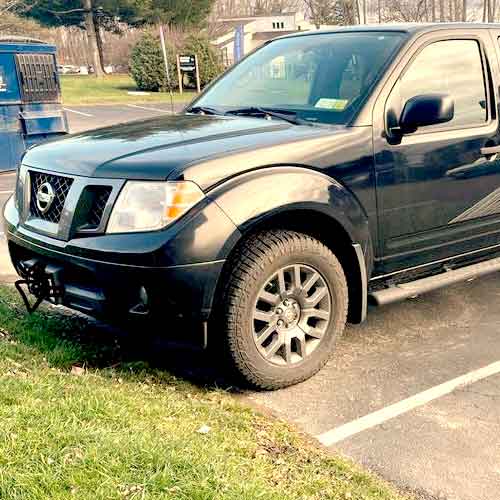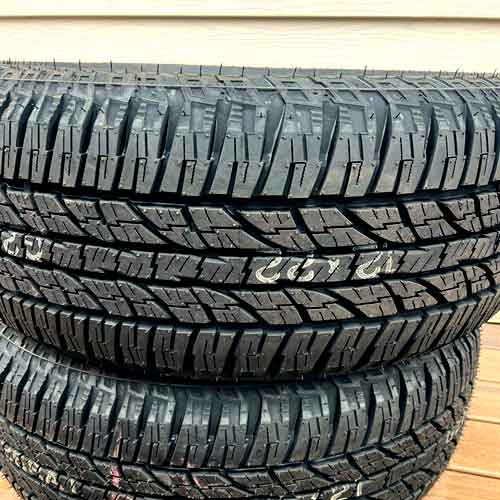Both the Pirelli Scorpion All Terrain Plus and the Yokohama Geolandar AT G015 are very much inclined towards on road performance, though both of them are also capable of taking you on slightly challenging paths as well.

Being a tire engineer in my opinion, the Pirelli Scorpion AT Plus provides a great dry grip without losing too much to fuel with lower rolling resistance, which also enhances the tire life as well. On the other side, the Yokohama Geolandar A/T G015 does things better in wet performance section, and it’s the most comfortable tire that you can get (in A/T category), where it’s flexible tread also offers superior snow performance, though the tire lacks in comparison on rougher tracks except for gravely roads.
Table of Contents
Tire Specs
The Yokohama Geolandar AT gives you a total of 112 sizes, where it ranges from 15 and goes up to 22 inches (rim diameter).
Sizes come in a wide range of load ratings where they are seen in SL, XL, C, D and E (max), so the weight of the tire also ranges wildly, 25 to 70 lbs.
Moreover, available speed ratings are R, S, T, and H (which is above average for an all-terrain tire).
Another plus for this tire is it’s tread depth, which although varies from 12/32″ to 18/32″, most sizes get to have 17/32″, which is again a lot, helping this tire with wear.
Speaking of which, the LT sizes come with 50k miles warranty, whereas the P metric sizes give you 60k miles.
On the other side, the Pirelli Scorpion AT Plus has limited 22 sizes (16 to 20 inches).
But the sizes still come with similar speed and load ratings, and still have lighter weights, (29 to 60 lbs).
Tread depth is lower as they are seen in between 13 and 16/32″. And all sizes have 50k miles warranty.
Tread Design
Let’s start things here with Yokohama Geolandar AT.

In comparison this tire does not make significant sidewall lugs, so that’s not worth discussing, though they do make sharp edges on shoulder lugs (towards outside).
They also have full depth notches and siping towards inner sides as well, where although siping design remains same across the tread, the notches vary a lot form rib to rib.
Like the inner most rib only has lateral groove notches while the surrounding ones are equipped with both laterally and longitudinally designed.
Moreover, all these ribs have secondary layers of rubber underneath, so it allows the tire to have more stability on pavements.
But they also restrict sideways movement of dirt and water particles a little bit as well.
On the other side, the Pirelli Scorpions AT plus yields an open design of S and P shaped lugs which I think is intentional.

Though these lugs are not for looks.
These 2 unique ribs offer with a lot of biting edges and offset sides which gives the tire a lot of grip form all directions.
Due to unique lug placement, the tire makes interconnected grooves where the inner ones laterally meet up with the outer wider circumferential channels.
Though the shoulder lugs are more compact in comparison and although it explains handling stability, the sideways removal of mud and dirt is limited here as well.
All lugs have full depth siping and although they may look interlocking from outside (making a 4 shaped design), they are not that way from underneath.
Meaning as the tire wears, you get to see that they are all rectilinear.
Tire Toughness
For tires that are made with off road capability, toughness matters a lot.
So, for that almost all tires are equipped with chip resistant rubber, but it’s actually the inner construction of the sidewalls that matters the most, as they are most susceptible to damage/getting punctured.
Both tires offer 2 ply polyester casing/cover, on which 2 steel belts run and then they are wrapped with nylon cap plies.
So here only this polyester casing is the one protecting the sides, as the rest of the layers are only underneath middle part of the tread.
But you can still consider Pirelli Scorpion AT Plus as slightly tougher, as it’s sidewall lugs protect the tire form there with thicker layer.
Moreover, this tire also has 2 cap plies of nylon compared to Yokohama G015 A/T with single ply.
Off Road Traction
Off road things get tough very fast. Here I am spiting the section with types of terrains as each requires different set of skills.
On Mud
On mud you are required with a highly voided tire, and all-terrain tires don’t offer wide enough grooves.
That’s the reason why mud-terrain tires with such balder design do so good on this terrain (and are named that way).
Compared to Yokohama AT, the Pirelli AT Plus with it’s web of tread voids in the middle interconnected with each other offers a superior performance. It also offers proper mud scoops on sides, and U shaped sidewall lugs which act as mud spoon, digging, and swooping the thick dirt out, while the tire moves forward.
On Rocks
On rocks you need durability, grip and sidewall lugs. With larger durability, the tire can bear the heavy scratching of hard rocks. And with stronger grip, it can stick in a wide angles range.
Here again the Pirelli Scorpion AT Plus is a better choice, as it’s open tread design allows powerful bite, and it’s staggered shoulders offers lateral traction.
Moreover, the sidewall lugs add to that traction, especially with lowered PSI (pressure).
On Snow
All Terrain tires which are better able to handle this terrain are rated with 3 Peak Mountain Snowflake symbols, which tell that they are good for even sever winter conditions.
Both tires in question here have this rating, yet the Geolandar AT is still a better pick in comparison.
That’s because the tire’s groove notches (where the central rib has lateral, and outer ribs have longitudinal), and saw-tooth sipes are every efficient in not only grabbing snow, but also ice.
It’s softer compound is also not that susceptible of getting stiffer with freezing temperatures.
Fuel Use
To put simply, the more resistance to roll a tire has, the more energy (fuel) would get used.
With stickier composition and heavier weight, some tires don’t let go off roads easily, so they generate a lot of rolling resistance which lowers their fuel economy.
Here one tire, Yokohama Geolandar AT although is lighter in weight (just 5 lbs on average), it’s stickier rubber consumes more fuel compared to Pirelli Scorpion All Terrain Plus.
On Road Performance
When it comes to highways, where most of the A/T tires are not expected to perform too well, our tires here are not included in there.
This is because these tires give you a better directional and lateral traction. Let me explain how.
Braking (Directional)
Braking comes under directional grip of the tire, so here acceleration also has a big role to play. This grip of the tire depends on the middle area of the tread, as that makes the most contact with the road (and with more pressure as well).
If you consider the above tread section again, you’d realize how closed up is the tread of Yokohama Geolandar AT G015, this allows this tire to have more rubber real estate available that would be in contact with the pavement, so it’s better in this department.
The opposite is happening in handling.
Handling (Lateral)
Handling has to do with shoulders, that’s because when a tire turns, all of the pressure gets there, so Pirelli AT plus with slightly more packed together lugs offers a greater no. of lateral traction G forces.
The tire is also firmer too, so this aids in lateral stability as well (the softer the compound, the more the lag in steering response).
Wet Traction
All-Terrain tires compromise on wet traction a little bit for off road performance as they offer less grip and hydroplaning resistance compared to passenger tires. Let me explain them both separately.
Wet Grip
The wet grip rating indicates how well the tire will behave in wet conditions. And here the better the tread evacuates water, the better the performance.
Though grooves come in to action here, sipes play a major role as water gets stuck between them and surface.
Sipes basically take in the water in their slits and then they spray it out later as the tire rolls over and goes back in the air, (allowing air to fill in those slits back again).
So more number of siping in Yokohama Geolandar AT G015 offers better traction, but that’s not all.
Sipes also need stretchability to move, otherwise they wont wipe off water, and this tire also offers that.
(Designing of the sipes is also another key factor, but I covered it in the tread section above).
Hydroplaning
When a tire floats on water, or you can say it hydroplanes on water (as it’s same thing), it loses all its traction. It does this because of the nature of water structure, it’s in-compressible, so it has to be removed in order for tires to grip.
So here grooves are important, which let the water path to move out.
So with balder design, the Pirelli Scorpion All Terrain Plus does a better job here.
Ride Quality
Quality of the ride has to do with overall tire’s noise (it generates on roads), and it’s ability to absorb the imperfections of the road.
And Yokohama G015 is better in both. In fact it’s top ranking here compared to other AT tires as well, that’s why I added it in my list of best A/T tires, check it out here: https://tiredriver.com/best-all-terrain-tires/
The tire is also pretty comfortable, as it’s spongy rubber is very efficient in providing you with secondary suspension.
It’s tread depth which reaches up to 17/32″ offers a lot of rubber matters between you and the surface, absorbing all the minor and even slightly major bumps along the way efficiently.
Conclusion
Pirelli Scorpion AT Plus is quite old now, yet the tire is still pretty great in many areas, where in comparison it does better on dry roads, fuel economy and almost all off road terrains.
On the other side, the Yokohama Geolandar AT remains unbeatable in providing you with excellent on road comfort both in terms of noise and ability to absorb bumps.
The tire is also very impressive on snowy terrains and on wet roads, it’s steering response and handling abilities is just as great as any passenger tire.
I’ve had my AT+ on my Xterra for 2+ years and they still look newish.
I am constantly forgetting that I have ATs when on the road due to the incredibly comfortable and competent Pirellis.
I also haven’t been stuck yet when going on forest service roads.
I find it difficult to believe that an AT tire outdoes the AT+’s on-road performance, but those Yokohama’s I’m already eyeing for the family EV, so, we’ll see!